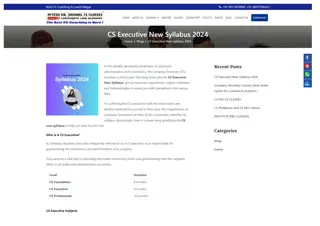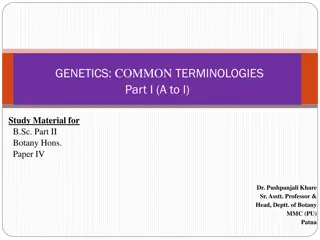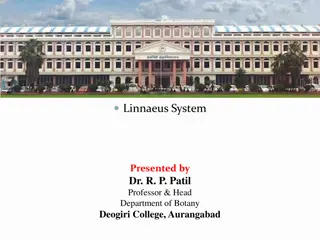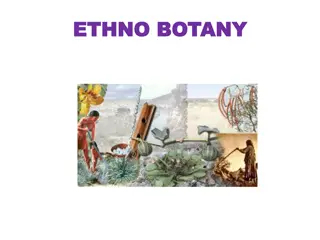Workshop on T.Y.B.Sc. Botany Revised Syllabus Semester VI at R.P. Gogate College of Arts & Science and R.V. Jogalekar College of Commerce
This workshop, held on 18th Feb 2019, introduced the revised syllabus for Semester VI of the T.Y.B.Sc. Botany program at R.P. Gogate College of Arts & Science and R.V. Jogalekar College of Commerce in Ratnagiri. The syllabus covers topics such as plant diversity, form and function, current trends in plant sciences, and practical applications, emphasizing areas like bryophytes, pteridophytes, gymnosperms, angiosperms, plant biochemistry, physiology, genetics, and biotechnology. The colleges have garnered accolades like the Best College Award and NAAC Re-accreditation.
Download Presentation

Please find below an Image/Link to download the presentation.
The content on the website is provided AS IS for your information and personal use only. It may not be sold, licensed, or shared on other websites without obtaining consent from the author. Download presentation by click this link. If you encounter any issues during the download, it is possible that the publisher has removed the file from their server.
E N D
Presentation Transcript
WELCOME To All At T.Y. B.Sc. Botany Revised Syllabus Sem VI Workshop 18 Feb 2019 R. E. Society s R.P.GOGATE COLLEGE OF ARTS & SCIENCE R.P.GOGATE COLLEGE OF ARTS & SCIENCE AND AND R.V.JOGALEKAR COLLEGE OF COMMERCE, R.V.JOGALEKAR COLLEGE OF COMMERCE, RATNAGIRI 415612 RATNAGIRI 415612 Best College Award by University of Mumbai 2007-08 NAAC Re-accredited -A Grade (3rdcycle) UGC s College with Potential for Excellence (CPE) DST FIST funded College ISO Certified Science faculty
UNIVERSITY OF MUMBAI Gogate Jogalekar College, Ratnagiri Syllabus for the T. Y. B. Sc. Program: B. Sc. Course : BOTANY Credit Based Semester and Grading System with effect from the academic year 2018 2019
Semester VI UNIT TOPICS Course Code USBO601 PLANT I Bryophyta II Pteridophyta III Bryophytes and pteridophytes: applied aspects IV Gymnosperms I Angiosperms II Anatomy II III Embryology IV Biostatistics DIVERSITY III USBO602 PLANT DIVERSITY IV
FORM AND FUNCTION III USBO603 I Plant biochemistry II Plant Physiology II III Genetics IV Bioinformatics CURRENT TRENDS IN PLANT SCIENCES II USBO604 I Biotechnology II II Plant geography III Economic botany IV Post harvest technology USBOP-IV Practical based on all the four courses in theory
USBO601 Plant Diversity III Unit 1: Bryophyta Life cycle of Marchantia Life cycle of Pelia Life cycle of Sphagnum Unit II : Pteridophyta Lepidophyta Classification, general characters; Life cycle of Lycopodium Calamophyta Classification, general characters; Life cycle of Equisetum Pterophyta Classification and general characters, Life cycle of Adiantum and Marselia
Unit III : Bryophytes and Pteridophytes: Applied aspects Ecology of Bryophytes Economic importance of Bryophytes Bryophytes as indicators Evolution of Sporophyte and Gametophyte Economic importance of Pteridophytes Diversity and distribution of Indian Pteridophytes Types of sori and evolution of sori
Unit IV : Gymnosperms Life cycle of Biota (Thuja), Classification Life cycle of Gnetum, Classification Life cycle of Ephedra, Classification Economic importance of Gymnosperms
USBO602 PLANT DIVERSITY IV Unit I : Angiosperms II Major Botanic gardens of India Indian Botanic Garden,Howrah; National Botanic Garden (NBRI) Lucknow; Lloyd Botanic Garden, Darjeeling; Lalbaugh or Mysore State Botanic Garden Banglore Botanical survey of India and regional branches of India Study of following plant families Rhamnaceae Combretaceae Asclepiadaceae Labiatae Euphorbiaceae Cannaceae Hutchinson s classification merits and demerits
Unit II : Anatomy II Ecological anatomy Hydrophytes submerged, floating, rooted Hygrophytes Typha Mesophytes Sciophytes Halophytes Epiphytes Xerophytes
Unit III : Embryology Microsporogenesis Megasporogenesis - Development of monosporic type, examples of all embryo sacs Types of ovules Double fertilization Development of embryo Capsella Unit IV : Biostatistics Test of significance student st-test (paired and unpaired) Regression ANOVA (one way)
USBO603 FORM AND FUNCTION III UNIT I PLANT BIOCHEMISTRY Structure of biomolecules: Carbohydrates (sugars, starch, cellulose, pectin, lipids (fatty acids and glycerol), proteins ( amino acids) Enzymes: Nomenclature, classification, mode of action, Enzyme kinetics, Michaelis Menten equation, competitive noncompetitive, and uncompetitive inhibitors.
UNIT II PLANT PHYSIOLOGY II NITROGEN METABOLISM: Nitrogen cycle, root nodule formation, and leg haemoglobin, nitrogenase activity, assimilation of nitrates, (NR, NiR activity), assimilation of ammonia, (amination and transamination nitrogen assimilation utilisation. Physiological effects applications of Auxins, Gibberillins, Cytokinins and Abscisic acid reactions), carbohydrate and and commercial
UNIT III : GENETICS Genetic mapping in eukaryotes: discovery of genetic linkage, gene recombination, construction of genetic maps, three-point chromosomes, problems based on the same Gene mutations: definition, types of mutations, causes of mutations, induced mutations, the Ame s test Metabolic disorders enzymatic and non-enzymatic: Gene control of enzyme hypothesis of inborn errors of metabolism, Phenyl ketone urea, albinism, sickle cell anaemia crosses and mapping structure Garrod s
UNIT IV: BIOINFORMATICS Organization of biological data, databases. Exploration of data bases, retrieval of desired data, BLAST. Protein structure analysis and application. Multiple sequence analysis and phylogenetic analysis.
USBO604 CURRENT TRENDS IN PLANT SCIENCES II Unit I PLANT BIOTECHNOLOGY II DNA sequence analysis Maxam Gilbert Method and Sanger s method Polymerase Chain reaction DNA barcoding: Basic features, nuclear genome sequence, chloroplast genome sequence, rbcL gene sequence, matK gene sequence, present status of barcoding in plants
Unit II: Plant Geography Phytogeographical regions of India. Biodiversity: Definition, diversity of flora found in various forest types of India Evolution of biodiversity with one example of an evolutionary tree Levels of biodiversity Importance and status of biodiversity Loss of biodiversity Conservation of biodiversity Genetic diversity- Molecular characteristics
Unit III: Economic Botany Essential Oils: Extraction, perfumes, perfume oils, oil of rose, sandalwood, patchouli, champaca, grass oils: Citronella, vetiver. Fatty oils: Drying oil (linseed and soyabean oil), semidrying oils (cotton seed, sesame oil) and non-drying oils (olive oil and peanut oil) Vegetable Fats: Coconut and Palm oil
Unit IV : Post Harvest Technology Storage of Plant Produce- Preservation of Fruits and Vegetables Drying (Dehydration)- (Natural conditions Sun drying; Artificial drying- hot air drying, Vacuum drying, Osmotically dried fruits, Crystallized or Candied fruits, Fruit Leather, Freeze Drying) Freezing (Cold air blast system, Liquid immersion method, Plate freezers, Cryogenic Freezing, Dehydrofreezing, Freeze drying) Canning Pickling (in brine, in vinegar, Indian pickles) Sugar Concentrates (Jams, Jellies, Fruit juices) Food preservatives Use of antioxidants in preservation
Reference Books Introduction to Plant Physiology by Noggle and Fritz, Prentice Hall Publishers(2002) Plant Physiology by Salisbury and Ross CBS Publishers Plant Physiology by Taiz and Zeiger Sinauer Associates Inc. Publishers, 2002 Genetics by Russel Peter Adison Wesley Longman Inc. (5th edition) An introduction to Genetic analysis Griffith Freeman and Company (2000) contd...
Fundamentals of Biostatics by Rastogi, Ane Books Pvt. Ltd. (2009). College Botany Vol I and II by Gangulee Das and Dutta Central Education enterprises. Cryptogamic Botany Vol I and II by G M Smith, Mcg raw Hill Physiological Plant Anatomy by Haberlandt, Mac Millan and Company Economic Botany by A F Hill, TATA McGRAW- HILL Publishing Co. Ltd. contd...
Post-Harvest Technology by Verma and Joshi, Indus Publication Embryology of Plants by Bhojwani and Bhatnagar An introduction to Embryology of Angiosperms by P Maheshwari, McGraw HillBook Co. Plant Systematics by Gurucharan Singh, Oxford and IBH Publ. Taxonomy of Vascular Plants by Lawrence George, H M, Oxford and IBH Publ.
Course outcome T.Y.B.Sc. Botany SEM VI USBO601PLANT DIVERSITY III To get knowledge of plant diversity with respect to cryptogams. USBO602PLANT DIVERSITY IV To get knowledge of plant diversity with respect to flowering plants and taxonomic literature. To study diversity in ecological anatomy and embryology.
USBO603FORM AND FUNCTION III To study different biomolecules, enzymes and steps in nitrogen metabolism. To acquire knowledge of genetic mapping, changes in gene sequences and metabolic disorders. To get knowledge of biological data, databases and to use the soft tools for data analysis and interpretation.
USBO604 CURRENT TRENDS IN PLANT SCIENCES II To study the methods of data generation at historical and community level. Use of plants aesthetically to get self employment. To study the methods of storage and preservation of fruits and vegetables for economic gain. To study the methods of extraction of volatile and fatty oils. To study distribution of plants and their diversity in India.
Methods of teaching and learning Sr. No. Method 1 Lecture 2. Inductive 3. Deductive 4. Demonstration 5. Project 6. Assignment 7. Seminar 8. Multimedia learning 9. Heuristic methods- self study Problem solving 10
STUDENT SUPPORT ACTIVITIES of Department of Botany To guide the students for research and other competitions To organize expert s lectures on Career opportunities. To design skill development programs for the students. Field visits, industrial visits and industrial training. To organize various activities under MOU program. To organize social activities such as nature walk, plantation. Prof. P. N. Deshmukh memorial program.

























